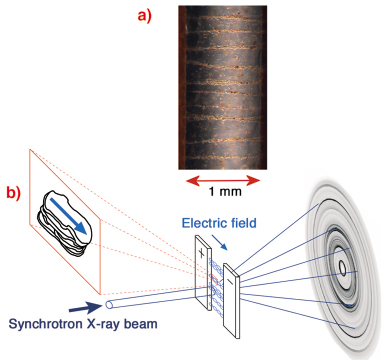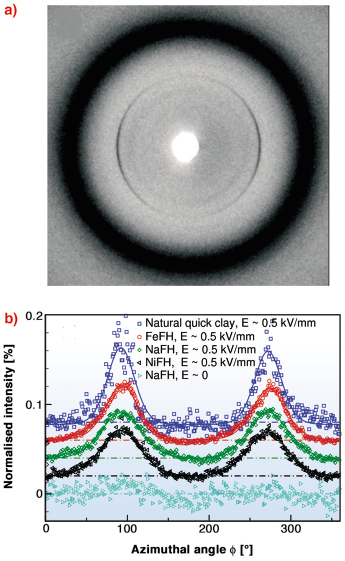- Home
- Users & Science
- Scientific Documentation
- ESRF Highlights
- ESRF Highlights 2006
- Materials Science
- Electric polarisation and chain formation of nanolayered particles
Electric polarisation and chain formation of nanolayered particles
When certain colloidal suspensions of electrically polarisable particles in insulating fluids are subjected to an external electric field, usually of the order of 1 kV/mm, the particles become polarised, and subsequent dipolar interactions are responsible for aggregating a series of interlinked particles that form chains and columns parallel to the applied field. This structuring occurs within seconds, and disappears almost instantly when the field is removed. The structuring coincides with a drastic change in rheological properties (viscosity, yield stress, shear modulus, etc.) of the suspensions, which is why such fluids are sometimes called electro-rheological fluids (ERs). The mechanical behaviour of such suspensions is readily controllable by means of the external electric field, which has stimulated a great deal of scientific interest both in academic and industrial areas. Based on the ER effect, several possible industrial applications have been proposed, including “smart” devices such as clutches, brakes, damping devices, actuators, fuel injection valves, hydraulic valves, bearing dampers, seismic damping frame structures etc. Furthermore, it has been suggested that ER fluids could be used as and in photonic crystals, light shutters, mechanical polishers, displays, ink jet printers etc.
Here we report structural studies of ER phenomena in systems consisting of nanolayered clay particles suspended in oil. Our optical microscopy observations show that suspensions in silicon oil of nanolayered smectite (swelling) clay particles, either synthetic or natural, undergo, when submitted to a strong external electric field, a fast and extended chain-like structuring characteristic of ER behaviour (Figure 26). This structuring results from interaction between induced electric dipoles of polarised clay particles.
 |
|
Fig. 26: a) Optical microscope image of ER chain formation in a cell of 1 mm electrode gap with an electrical field applied in the horizontal direction. b) Sketch of the reported X-ray scattering experiments. The magnified area sketches a single nano-layered clay particle inside a dipolar chain and the attached arrow indicates the direction of the dipole moment induced by the external electric field. A corresponding diffractogram is shown in Figure 27. |
The present synchrotron wide-angle X-ray scattering (WAXS) experiments were performed at the Swiss-Norwegian Beamline BM01A (SNBL), where diffractograms were recorded using a 2D Mar345 detector. These WAXS experiments provide information about the preferred direction of polarisation for individual clay particles, as well as information about the orientational distributions of polarised clay particles within the aggregated ER chain structures. Each individual clay particle is a stack of “nano-cards”, and thus a ring of Bragg powder scattering from randomly oriented clay particles in suspension is observed in zero applied electrical field, whereas anisotropic oriented powder scattering is observed above the ER triggering field of about 1 kV/mm (Figure 27). The reported experiments show that the clay particles polarise along their silica sheets, i.e. along the “easiest” direction for moving intercalated ions and water. A change in the platelet separation inside the clay nanolayered particles also indicates that intercalated ions and water molecules play a central role in their electrical polarisation. The resulting induced dipole is attached structurally to the clay particle, and this causes clay particles to reorient and interact, resulting in the observed macroscopic structuring. Therefore, the macroscopic properties of the reported ER clay suspensions could, in principle, be tuned by controlling the nature and quantity of the intercalated species, at the nanoscale. This creates an opportunity for novel ways of producing guided self-assembled nanostructures for implementation into nanocomposite materials design, as well as for use in connection with nanostructured templates.
 |
|
Fig. 27: a) 2D Mar345 detector diffractogram from ER-oriented clay in silicon oil suspension. The broad dark ring is the scattering from the silicon oil. The narrow anisotropic (001) Bragg peak is the 1 nanometre layer stack scattering summed from the suspended clay particles when an external electric field is applied as sketched in Figure 26. b) Azimutal representation of diffractograms of the type shown in the upper panel; scattering from ER structured chains formed in 4 different kinds of smectite clays are shown. Theoretical orientational fits are also included. |
Principal Publication and Authors
J.O. Fossum (a), Y. Méheust (a), K.P.S. Parmar (a), K.D. Knudsen (b), K.J. Måløy (c) and D.M. Fonseca (a), Europhysics Letters 74, 438-444 (2006).
(a) Norwegian University of Science and Technology, Trondheim (Norway)
(b) Institute for Energy Technology, Kjeller (Norway)
(c) University of Oslo, Oslo (Norway)



